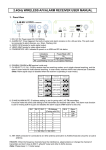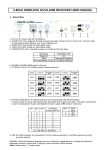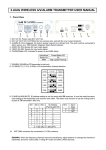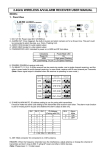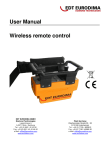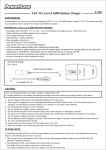Download 2.4GHz WIRELESS A/V/ALARM TRANSMITTER USER MANUAL
Transcript
2.4GHz WIRELESS A/V/ALARM TRANSMITTER USER MANUAL 1. Panel View 1. 2. 3. 4. 5. 6. 1 2 3 4 5 6 7 8 9 10 ○ ○ ○ ○ ○ ○ ○ ○ ○ ○ DC+12V IN: Power input DC+12V/1.5A. DC+12V OUT: DC+12V/750mA for box camera only, and with the over current protector. ALARM IN: Once triggered, the built-in buzzer rings on for a 20-sec time. This port could be connected to alarm sensor, e.g.: PIR Detector, Magnetic Reed Switch Detector. AUDIO IN: RCA female for input audio signal. VIDEO IN: BNC female for input video signal. POWER/State LED: Indicated to power on and ARM status. Indications Power On ARM Power/State LED On High speed Flashing 7. DISARM: DISARM at TX transmitter’s side only. 8. CH SELECT (1 2 3 4): 2.4GHz 4-CH transmission channel selection.[Default: In-Band 4-CH] (Note: Only one mode work at a time. If you want to use out-band mode, the TX transmitter and RX receiver must made the same jumper setting, please reference to the Appendix A.) In-Band Mode Out-Band Mode 9. ID AND ALARM MUTE: ID address setting is use for paring with RX receivers. It must be make the same code setting to link transmitter and receiver each other. The alarm mute function is use for muting built-in buzzer at TX transmitter’s side only. Bit 1 0 0 0 0 1 1 1 1 10. Bit 2 Bit 3 ID Address (Pairing with RX) 0 0 0 0 1 1 1 0 2 1 1 3 0 0 4 0 1 5 1 0 6 1 1 7 (1 = SW ON, 0 = SW OFF) Bit 4 0 1 Alarm Mute ON OFF ANT: SMA connector for connected to 2.4 GHz antenna. REMARK: When the frequency channels have the interference, adjust antenna or change the channel of transmitter and don’t close to 802.11 a/b/g AP router and other 2.4GHz devices, To use different transmitting channel would be avoid to interference other 2.4GHz device, especially set transmitting channel at out-band mode. 2. Caution for Installation 2.1 Be careful, never let any water in this equipment. 2.2 If necessary, use a soft cloth moistened with alcohol to wipe off the dust. 2.3 Be extra careful not to shake the unit. 2.4 Avoid places where temperatures exceed 50 o C or higher. 2.5 Avoid places where there are frequent vibrations or shocks. 2.6 When any abnormalities occur, make sure to unplug the unit and contact your local dealer. 3. Packing 3.1 Transmitter 3.2 Antenna 3.3 User manual 3.4 Screws 3.5 Plastic-Conical-Anchor 3.6 Power Adaptor ×1 ×1 ×1 ×4 ×4 ×1 [Option] 4. Specification In-Band CH1 CH2 CH3 CH4 4-CH 2414 MHz 2432 MHz 2450 MHz 2468 MHz Out-Band CH1’ CH2’ CH3’ CH4’ 4-CH 2490 MHz 2510 MHz 2390 MHz 2370 MHz RF IMPEDANCE 50 Ω Typical POWER SUPPLY DC12V/1.5A Adaptor CURRENT CONSUMPTION 350mA Typical , Start-up current 650mA ( DC12V Input) DC OUTPUT DC12V/750mA RF OUTPUT POWER 1.0 W VIDEOINTPUT 1.0 Vp-p Composite @ 75Ω AUDIO INPUT 2.0 Vp-p Typical, 2.7 Vp-p Max. @ 600Ω ALARM INPUT TTL/CMOS (Level Detection) DIMENSIONS (without Antenna) L:86 mm H:30 mm D:110 mm CHANNAL/ FREQUENCY Q2010/05/17 Appendix A: How to Shift the TX Transmitter and RX Receiver from In-Band 4-CH to Out-Band 4-CH by Jumper Setting. STEP 1: Unscrew back-panel screws. TX RX STEP 2: Pull the board outside and you can see a jumper there. (Note: Don’t pull too much. Same as the picture bellow is good.) RX TX STEP 3: Jumper configuration for 2.4G TX and RX. In-Band Out-Band TX In-Band Mode In-Band RX Out-Band Out-Band Mode




